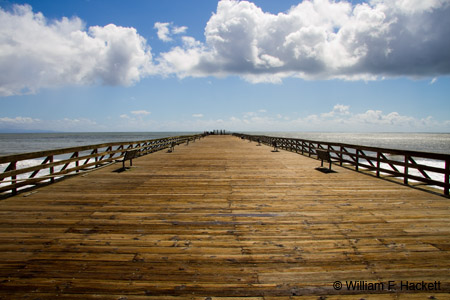Shark Week? :-)

Make that SHARK SEASON! 😉
(Tracking sharks? “There’s an app for that!®” – Registered Trademark Apple, Inc.)
More about the app, later! 😉
The annual migration of great white sharks (Carcharodon carcharias) is in “full gear” as reports of the predators in shallow, coastal waters keep coming! The beasts have returned to their feeding grounds in the so-called “Red Triangle,” an area that is roughly between Monterey Bay, the Farallon Islands (read about the Web cam here), and Bodega Head, but sharks have been observed all along the coast, including one that is 20 feet long that was seen last weekend next to Moss Landing Harbor!
My photo above shows the pier at Seacliff State Beach. SFgate.com offers a warning to “cannonballers”  from Sean Van Sommeran, the executive director and founder of the Pelagic Shark Research Foundation in Santa Cruz:
from Sean Van Sommeran, the executive director and founder of the Pelagic Shark Research Foundation in Santa Cruz:
“…a 10- to 12-foot shark that was so close to a pier at Seacliff State Beach, east of Capitola, that “you could have literally cannonballed off the side into the shark.”
Sommeran said he also spotted a white shark lurking around dolphins off Manresa State Beach last weekend.
“Usually, we see them around dolphins, which is an important safety tip because there are still a lot of people who think dolphins make you safe against sharks,” Van Sommeran said. “These big sharks eat dolphins.”A 20-foot shark, one of the biggest ever seen in the area <and close to the RECORD!>, was reported by a Monterey Bay tour boat company last weekend near the mouth of the Pajaro River.
Scientific researchers (sometimes I STILL think like one! 😉 ) have a new, robotic device to learn more about great white sharks! According to SFGate.com:
“What we are trying to build right now is a wired ocean with a network of interactive devices that will tell us where the animals are,” said Barbara Block, a professor with the department of biological sciences at Stanford University‘s Hopkins Marine Station.
The new robot, called the Wave Glider, is a solar-powered device with a satellite hookup developed by Sunnyvale‘s Liquid Robotics. The mobile surfboard-like gadget propels itself using wave energy and carries receivers and a global positioning system.
The remote-controlled device, which is just now returning to San Francisco area waters after a trip up the coast to Oregon, is the latest addition to a growing arsenal of technology that is being used to study sharks. Transmitters have been attached to 100 sharks, and the acoustic pings of predators passing within 1,000 feet are being picked up by receivers affixed to buoys in known shark hangouts.
The eight Stanford scientists on Block’s team have been working with marine biologists at the Monterey Bay Aquarium on the program for monitoring sharks, Tagging of Pacific Predators, or TOPP (scientists like acronyms ALMOST as much as the military and high-tech engineers! 😉 ) for almost 10 years. Their 2009 study determined that the great white sharks of this region, northeastern Pacific white sharks, are genetically unique among the great white sharks of the world.
The great white sharks leave a deep ocean spot (dubbed the White Shark Café) near Hawaii in August, and almost ALL of the sharks are along the West Coast of the U.S. mainland in the fall! The great whites begin to leave for the deep ocean again in December. Females typically visit the Gulf of the Farallones in alternate years, which suggests that their migration pattern is tied to a two-year reproductive cycle.
On the Central California Coast, there are an estimated 220 ADULT great white sharks and an unknown number of infants and juveniles. When combined with the estimates of another group of scientists (I wrote about them in March of 2010: “Great white shark vs. giant squid”), who study great whites that frequent Guadalupe Island in Mexico, there is a total of 339 adult great whites along the West Coast, a very small number, considering the number of reported sightings!
This fall, the scientists at Stanford and the Monterey Bay Aquarium plan to take DNA samples from, and affix acoustic tags to, another 30 individuals. They will also photograph the distinctive dorsal fins.
Great white sharks average 15-16 feet in length, but can grow to 20 feet and 4,800 pounds. The largest one ever caught (in 1939) was 21 feet (6.4 m) long and weighed 7,300 pounds (3311 kg).
Read the SFGate article about “Tom Johnson,” the best-studied shark in the world, which has been studied for 26 years and returned this year, on schedule, to Tomales Point!
The California Academy of Sciences has advice for surfers, swimmers, kayakers, and divers in how to avoid sharks at calacademy.org
Oh yes! Stanford’s Hopkins Marine Station and the Monterey Bay Aquarium now have an iPhone and iPad app called Shark Net, which people can use to track the great white sharks’ acoustic signals. As of August, the app was not yet on Android devices. 
-Bill at
Cheshire Cat Photo™ – “Your Guide to California’s Wonderland™”
You can view higher-resolution photos at the Cheshire Cat Photo™ Pro Gallery on Shutterfly™, where you can also order prints and gifts decorated with the photos of your choice from the gallery. The Cheshire Cat Photo Store on Zazzle® contains a wide variety of apparel and gifts decorated with our images of California. All locations are accessible from here. LIKE Cheshire Cat Photo on Facebook here! If you don’t see what you want or would be on our email list for updates, send us an email at info@cheshirecatphoto.com.







